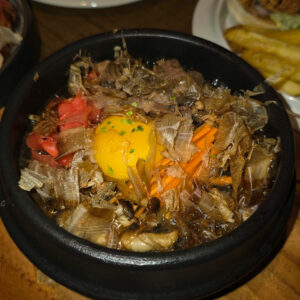MARTIN NARISMA, best known for his work as food editor with The Fat Kid Inside Studio’s Featr channel, opened a restaurant earlier this year. If you find yourself trying to reach in through the screen to taste what he makes on YouTube and Instagram, his Quezon City restaurant — Gacha by High Table — gives you a chance.
The thing is though, the menu, crafted by him, is highly personal: it goes beyond social media fanfare and uses simple dishes to tell a story about someone.
MAMA’S SUKIYAKI — SORT OFWhen we sat down to a tasting on Aug. 9, as a fan of soup, the Socorro caught our eye. It is a dashi broth reduction, glass noodles, egg, beef, tofu, mushrooms and vegetables — much like a sukiyaki, with a few modifications. This dish was named after his mother (a newspaper editor). “She’s not the best cook in the world, but she can make a good sukiyaki,” said Mr. Narisma (he did say he didn’t add her more radical modifications though). “This is my tribute to my mom,” he said. The movement of katsuboshi flakes on top made for a tantalizing dish, but we were pleased to find out that the dish itself is a milder, more mellow version of its Japanese version.
Another dish is the Lumen, named after his paternal grandmother. His father really liked nilaga (a soup made of boiled beef), and due to a history of heart disease in the family, a lot of the dishes from his grandmother’s kitchen were boiled or stewed.
The Lumen is not a soup: it is beef shank braised in red wine for eight to 10 hours, served on a bed of mashed potato and mushrooms, that came tucked with hidden pieces of garlic confit, then with a side of seared cabbage. There’s a “gravy,” but it’s purely just the collagen and juices from the braising process (deliciously sticky). The dish, despite its heavyweight accompaniments, had a subtle and clean flavor, belying all the work that went into it — funnily enough though, it still tasted familiar, like a nice bulalo (bone marrow soup).
There are smashburgers for more casual diners: uniformly, they had an excellent charred taste complementing a strong, savory flavor.
Dessert was another personal story: Pahar is the nickname of someone who taught him about pastries, but this one is just a simple suman (rolled rice cake), latik (coconut sugar), a tablea chocolate mousse, and vanilla ice cream. We admit that rice desserts aren’t our favorite, but as we savored and nibbled and finished this dessert, we were reminded of our lola’s champorado (grandmother’s chocolate rice pudding), and then every chew felt like we were chasing a memory.
“It’s basically a story of my experience as a culinary person,” said Mr. Narisma.
Even the appetizer, for example, is a fixed version of the quick salads his first boss would sit him down to eat when he wouldn’t pause working in his first job at a French restaurant. Meanwhile, the Japanese-inspired menu at Gacha is a tribute to his second job, as a chef for a conglomerate. That job forced him to explore other cuisines outside his French-style training.
“That’s where I saw which cuisine kind of suits my palate, and which one was easy for me to make. Most of those were Japanese,” he said. “I’m not well-versed on Japanese cuisine, but what I do is apply my experience and techniques I know.”
INSPIRATION, MODIFICATIONThe restaurant is called Gacha after the gachapon machines in Japan that dispense random items: “The plan was not to have the same menu forever. You’ll be surprised the next time you visit.” However, he and his partners (he’s in charge of the kitchen; the others are in charge of finances, the bar, design, etc.) decided not to follow the tasting-menu model of changing the entire menu seasonally: “I don’t want people missing dishes too much.”
The prices are also quite fair, with nothing going past P700. There’s also a selection of cocktails, crafted by one of the restaurant’s partners, and they have a partnership with Treeline Ales, served on tap.
Mr. Narisma also co-owns two fried chicken joints; one in the surf town of La Union and the other in the bohemian district of Poblacion in Makati. He explains that fried chicken is his favorite dish, but that not many chefs eat their own cooking. “That was goal: I want to make fried chicken that I will eat, and hindi ako magsasawa (I will not tire of it),” he said. “I can still eat my own fried chicken, until now.”
He connects that with Gacha’s story: “Everything came from my — corny — heart and experience.”
COOKING ON CAMMr. Narisma discussed as well the difference between cooking in the kitchen and cooking on camera (as his day job dictates). “In front of the camera, especially the non-live ones, you have more control,” he said.
“Here [in the restaurant], you really have to pay attention to what you’re doing. Every simple mistake is a cost and a waste of time and resources,” he said. “But dito, sobrang derecho sa iyo ng resulta (but here, the results are more direct). If the customer likes it, you’ll see it on their faces.”
Attending focus group discussions for various restaurants and products, he was taught how to read customer body language to find out if they like something: “When they take a bite, they start nodding. They start pointing to the food, or looking at their seatmates,” he said. When he looks around in Gacha, “I’m happy that the food that I like is liked by others too.”
Gacha by High Table — at 219 J.P. Rizal, Project 4, Quezon City — serves casual fine dining from Wednesday to Sunday, from 3 to 11 p.m. on weekdays, and lunch from noon to 3 p.m. and dinner from 6 p.m. to midnight on weekends. — Joseph L. Garcia

